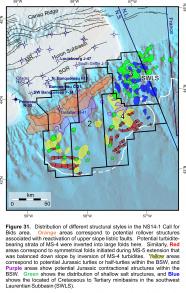Source Rocks
Both gas and oil prone source rocks are possible for the NS14-1 Call area. Oil and gas discoveries have been made on the outer shelf just landward of the Call area (e.g. oil and gas in Primrose N-50, gas in Banquereau C-21), with several additional wells encountering flow tested gas shows (e.g. N. Banquereau I-13, SW Banquereau F-34, Louisbourg J-47), minor gas shows (Citadel H-52, South Griffin J-13, Tantallon M-41), or spotted oil staining (e.g. South Griffin J-13) (Fig.31). In addition, up to 5% TOC type II to III source rocks were encountered in Tithonian strata in Louisbourg J-47 (OETR, 2011), less than 40 km northeast of Parcels 1 and 2. A review of this and other potential source rocks is provided in the following section. It should be noted, however, that our choice to carry the top Jurassic marker above the Banquereau Synkinematic Wedge, rather than below it as was done in the Play Fairway Study, will substantially alter the source rock maturation work published in OETR (2011) for the eastern Scotian Slope, and for areas underlying the Sable Slope Canopy further west. For Middle to Late Jurassic source rocks, this change could have a positive impact (bringing them into the oil window at a later stage). For older source rocks below the Banquereau Synkinematic Wedge, like the theoretical Pleinsbachian (OETR, 2011) that is already overcooked in the NS14-1 Call area, this change means these source rocks would have been buried deeper for a longer period of time.


